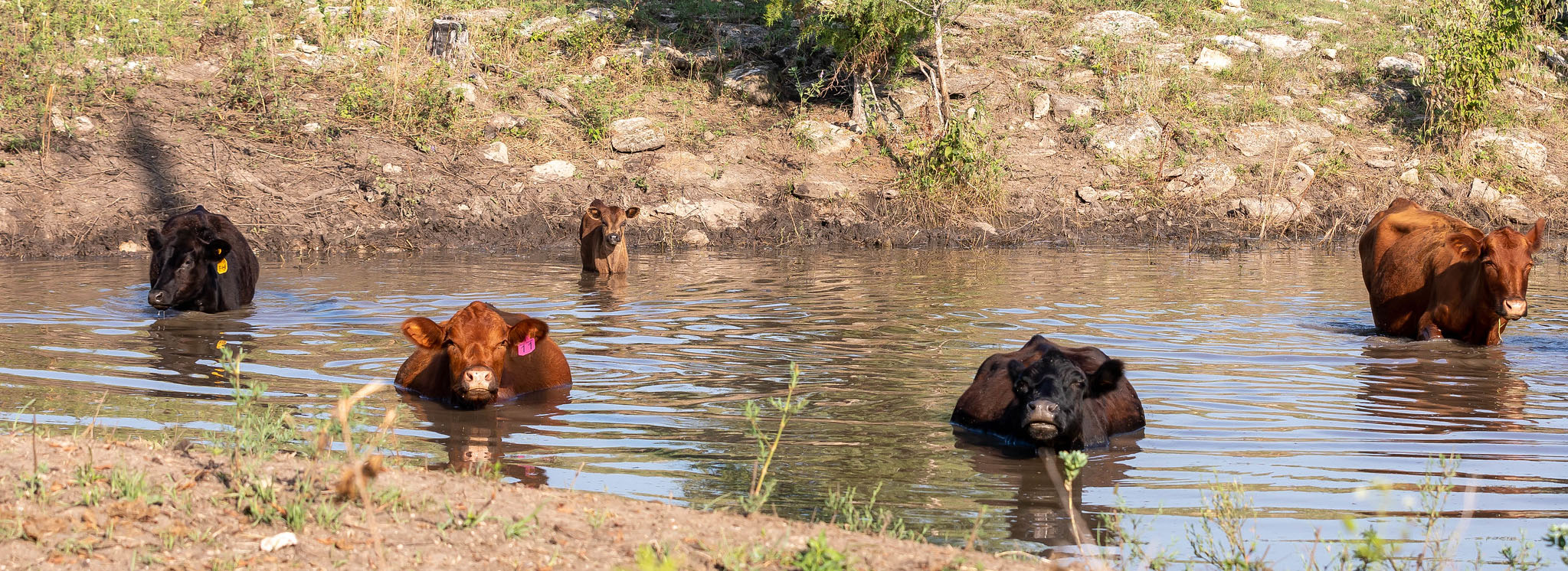
Allowing cattle full access to pond water will lower the water quality, said K-State Research and Extension fisheries specialist Joe Gerken. | Download photo
Cattle Chat: Water requirements in the summer
K-State beef cattle experts discuss how ponds can be a source of water for animals in pastures
At a glance: K-State Beef Cattle Institute experts and K-State extension specialist Joe Gerken talk about how to safely source water from ponds.
More information: Joe Gerken, 785-532-1418, gerkenje@ksu.edu; Phillip Lancaster, 785-532-6323, palancaster@vet.k-state.edu; Bob Larson, 785-532-4257, rlarson@vet.k-state.edu
Related: Beef Cattle Institute Cattle Chat
June 25, 2024
By Lisa Moser, K-State Research and Extension news service
MANHATTAN, Kan. – On a hot summer day, there is nothing better than a cool drink of clean water to quench one’s thirst. For cattle out on pasture, their need for clean, accessible water is important for good health, said the experts from Kansas State University’s Beef Cattle Institute on a recent Cattle Chat podcast.
“Cattle that are eating dry hay will need to consume more water than cows eating fresh grass, and if they are in a hot environment they’ll drink about twice as much water as cows in the winter,” K-State beef cattle nutritionist Philip Lancaster said.
In the summer, Lancaster estimates the cows need to drink about two gallons of water for every 100 pounds of body weight. And adult cattle aren’t the only animals on pasture with a need for water.
“Even though their diet is mainly milk, calves also need to drink water to help their rumen properly digest any foods they are starting to consume,” Lancaster said.
Not only is it important to provide water access for cattle, but the quality of the water is key to good health, K-State veterinarian Bob Larson said.
“Anytime cattle are not hydrated as well as they could be, they are suspectable to disease as in the case of pneumonia,” Larson said.
One source of water for cattle on pastures is ponds.
“When the water quality is important, it is best to keep the cattle out of the ponds by fencing them out and piping the water to a tank,” K-State Research and Extension fisheries specialist Joe Gerken said. “Having a pipe that runs through an earthen dam regulates the temperature so the cattle will want to drink more.”
Another option is to grant the cattle limited access to the pond by fencing them out except for a gravel path to one part of the pond, Gerken said.
“Depending on the herd size, generally speaking, this path is from 20-40 feet wide, and because it is gravel, the cattle won’t linger as long due to the way it feels on their hooves,” Gerken said.
He also said the gravel keeps sediment from filling the pond.
“With this system, the pond can be healthy, and the cattle can still get the benefits they need from it,” Gerken said.
To hear the full discussion, listen to Cattle Chat on your preferred streaming platform.
***

K‑State Research and Extension is a short name for the Kansas State University Agricultural Experiment Station and Cooperative Extension Service, a program designed to generate and distribute useful knowledge for the well‑being of Kansans. Supported by county, state, federal and private funds, the program has county extension offices, experiment fields, area extension offices and regional research centers statewide. Its headquarters is on the K‑State campus in Manhattan. For more information, visit www.ksre.ksu.edu. K-State Research and Extension is an equal opportunity provider and employer.